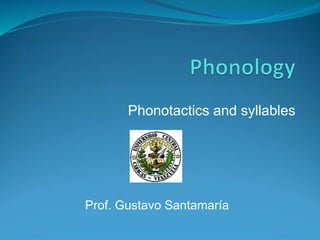
Phonotactics and syllables
- 1. Phonotactics and syllables Prof. Gustavo Santamaría
- 2. Let’s combine the following sounds to form English words: /ŋ/ /i/ /t/ /k/ /t/ /Ɛ/ /n/ Is it possible? Why?
- 3. Each language has rules to combine its sounds. These rules are language specific! What is possible in English may not be possible in Spanish! These rules of sound combinations are known in phonology as Phonotactics.
- 4. Phonotactics The constraints on positions and sequences of sounds in a language. Some rules: Combination of /pn/ in intial position of a word is not permitted in English. /ŋ/ is never word initial /ʒ/ is never word initial, but common word medially.
- 5. Phonotactics Some rules: /h/, /j/, and /w/ are always syllable initial before stressed vowels (house, youngster, wonderful) /ð/ is word initial only in certain pronouns, adverbs, demonstratives, but never in nouns, verbs, and adjectives. Otherwise, it occurs freely word medially or word finally. …and some other rules…
- 6. Phonotactics Phonotactics operate in larger phonological units called: The syllables What is a syllable? How do speakers determine the number of syllables in a given utterance?
- 7. Defining the syllable A phonological unit Larger than the phoneme Psychological features: Almost all speakers divide words into syllables not into sound segments. Speakers of a language will divide the same word into more or less the same number of syllables.
- 8. Defining the syllable Production and recognition: It’s a geniune and easily recognized unit of speech. Easy to identify, impossible to define. Hypothesis: The syllable is a group of sounds produced by a single puff of air (chest pulse). What about the words “city” and “pots”? One or two chest pulses?
- 9. Defining the syllable • Production and recognition – Speakers may recognize two syllables, but only one chest pulse. – Recognition must combine a number of features: • Sonority (relative prominence) • Stress • Length • Pitch • Certain phonetic features (beginnings and endings of syllables)
- 10. Syllabic segments Syllabic segments: Each syllable = one prominent segment (vowel or sonorant*) Vowels are almost always syllabic (vowel symbols involve syllabicity). Consonants are usually non-syllabic (consonant symbols don’t involve syllabicity) Syllabic consonants need a mark (diacritic) to indicate syllabicity. For example: / l / *Sonorant sounds: glides /w, j/; liquids /l, r/; and nasals /m, n, ŋ/
- 11. Syllabic segments Syllabic segments: Usually syllabic consonants are liquids or nasals. Rarely fricatives work as syllabic consonants ([pst]) The division between syllables (syllable juncture) is marked with a hyphen [-] or with a dot [٠] Example: “city” syllabification = [sIt-I] “mistake” syllabification = [mI-steik] “mistime” syllabification = [mIs-t aIm] Syllabic segments represented by V, non-syllabic ones represented by C. h
- 12. Syllable structure Syllable Onset: segments that precede the peak Core (Rhyme) Peak (Nucleus): the syllabic segment Coda: segments that follow the peak
- 14. Syllable structure About the coda: When it is present, the syllable is CLOSED or checked. When it is absent, the syllable is OPEN or unchecked.
- 16. Coda restrictions in English • Closed syllables may vary from 1 to 4 consonants in word final position: – Examples: • 1: Top /tap/ , lock /lak/, meet /mit/ • 2: Apt /æpt/, fix /fIks/, list /lIst/ • 3: Mumps /mʌmps/, puzzled /pʌzld/, twelfth /twƐlfƟ/ • 4: Sixths /sIksƟs/, prompts /prampts/, twelfths /twƐlfƟs/ • Open syllables: only tense vowels occur in stressed syllables with no coda (me /mi/, saw /sͻ/, true /tru/).
- 17. Onset restrictions in English • Syllables may have onsets from 1 to 3 consonants: – Examples: • 1: tea /ti/ • 2: try /traI/ • 3: stress /strƐs/ – Onsets of 3 consonants follow the pattern: • 1st sound = /s/ • 2nd sound = voiceless stop /t, p, k/ • 3rd sound = /l, r, w, j/ splash, strike, squeeze, studio* /j/ or /u/
- 18. Onset restrictions Onsets of 2 consonants are: /p/ + /l, r, j/ = plural, prize, computer /t/+ /r, j, w/= triumph, tune, twelve /k/+/l,r,j,w/= clown, crack, cute, quick /b/+/l,r,j/= blue, brown, beautiful /d/+/r,j,w/= dry, dual*, dwelling /g/+/l,r,j,w/= glow, grape /m/+/j/= music /n/ + /j/= new
- 19. Onset restrictions Onsets of 2 consonants: /l/ + /j/ = lure /f/+/l,r,j/= flaw, fry, furious /v/+/j/= view /Ɵ/+/r,j,w/= through, thwart /s/+/l,j,w,p,t,k,m,n/= slide, splash, stake, smack, snake, sweet /ʃ/+/r/=shrink, shrimp /h/+/j/= huge